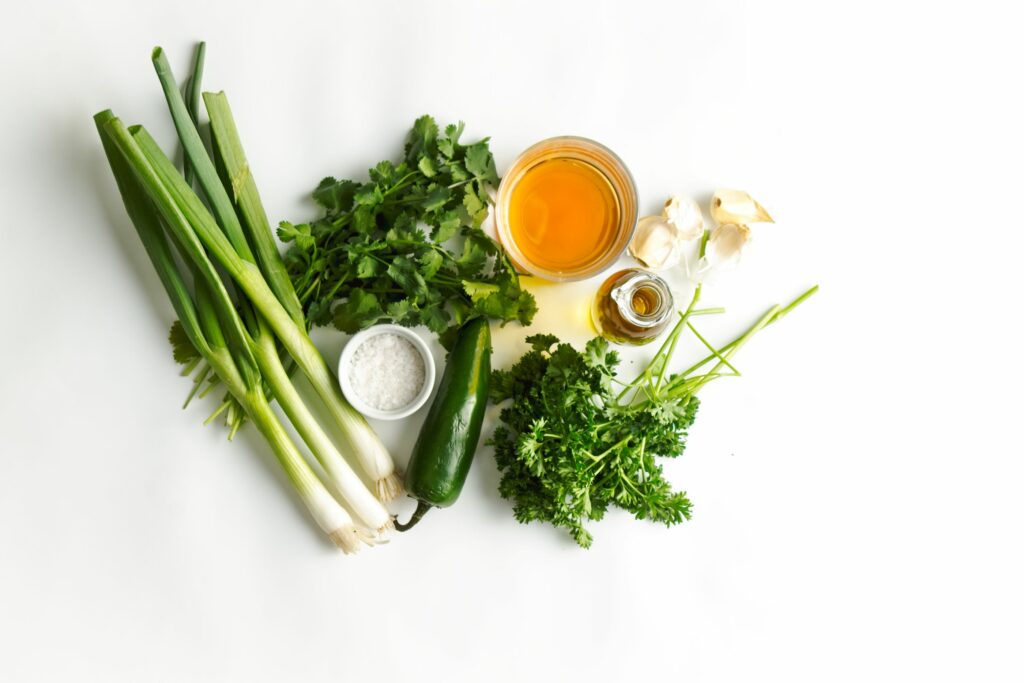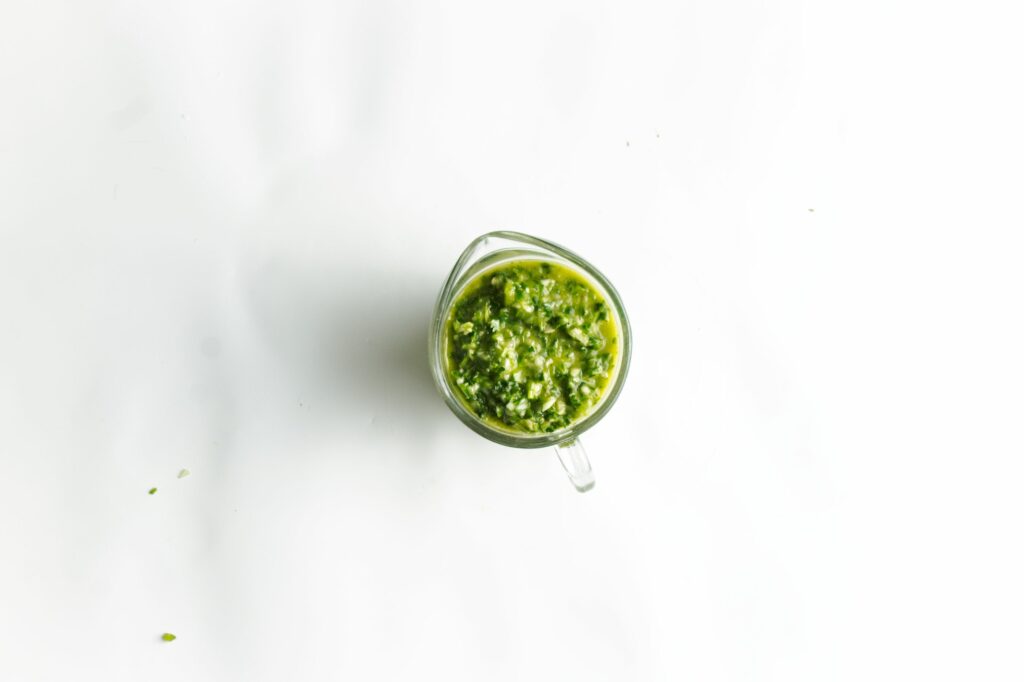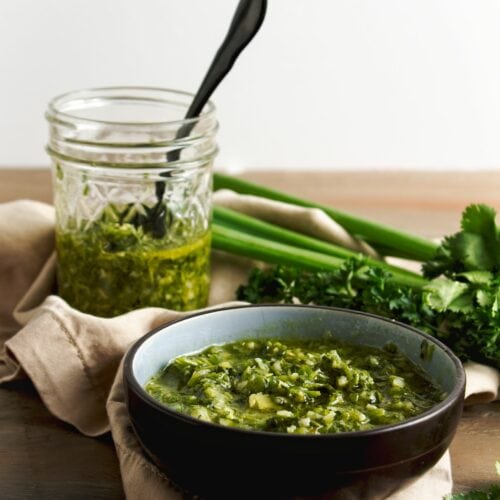Think you can’t make your own vegan chimichurri sauce at home? Think again! Chimichurri sauce is almost as easy to make as it is to open a jar of store-bought sauce! Plus, you can control your own seasonings and other ingredients used. This home-crafted chimichurri sauce has the added zing of green onions for a rich, highly flavorful, vegan topping or sauce you can spoon onto your tofu creations, veggies, or salads.

When you think about chimichurri, you might wonder if it’s vegan. After all, chimichurri sauce is usually associated with Argentine grilled meats. And so if you are like me, you avoid it. For Years. Needlessly. Because nothing could be further from the truth! Because chimichurri sauce is, in fact, usually vegan!
In fact, chimichurri is typically made with various chopped herbs, oil, and vinegar and can be used on a variety of food – many of them vegan! Grilled veggies or tofu are perfect to spread with a dollop of flavorful chimichurri. Make a grilled tofu wrap and bring on the flavor!
Vegan food is definitely not boring! Any "plain" or neutral food can be jazzed up with any varity of vegan sauces, dressings, or dips. You just have to experiment a little to find out! Chimichurri sauce is absolutely perfect with grilled tofu wraps and adds just the right zip of flavor!
Some of my favorite vegan sauces I use to bring flavor to my vegan recipes include jalapeno ranch dressing, blue cheese dressing, green goddess dressing, and tzatziki sauce. All vegan and ALL delicious!
You’ll love the bright tangy zip that green onions add to the vegan chimichurri sauce. And this is the beauty of making your own chimichurri from scratch – you get to use your favorite seasonings, herbs, and vinegar.
Traditionally, chimichurri was made with (white) vinegar, finely chopped parsley, oregano, and garlic – all in an olive oil base. But over the years home cooks have taken liberty with the ingredients used and substituted and added their favorites.

Ingredients needed to make your own hand-crafted chimichurri sauce.
- olive oil – I prefer to use robust-flavored olive oil.
- red wine vinegar
- green onions – You will be using the green stems as well as the white bulbs in this recipe.
- One medium jalapeno – If you really like the heat from jalapeno, then go ahead and use the whole thing, seeds and all. If you prefer a little less heat then remove the seeds and white parts holding the seeds before chopping. If you are trying to make this sauce family-friendly with very little heat, then use jarred tamed jalapenos.
- fresh parsley leaves – You will be chopping before adding them to the food processor.
- fresh cilantro leaves and stems – Again, you will be chopping the cilantro before adding it to the food processor.
- 4 cloves garlic – You will need to chop before adding the garlic to the food processor. Or, you can use jarred chopped or minced garlic. I use about one teaspoon per clove (estimating that my cloves would have been large).
- salt – I love to use coarse sea salt for this recipe.
- You’ll also need a food processor. I love using a mini food processor for its ease of use and cleanup. You can also finely mince the ingredients by hand before mixing them with the red wine vinegar and olive oil.

How to make chimichurri sauce from scratch
The exact ingredients with measurements can be found in the recipe card below along with more concise abbreviated instructions. Read on for more details, tips, and tricks so that you will feel confident making this recipe.
Steps 1-3: Prepare the herbs and veggies
You might wonder why we need to chop and mince the ingredients if we are just going to throw them in a food processor anyway. This sauce needs to be minimally processed because chimichurri should have a little texture, not be a purred sauce. Pre-chopping the ingredients gives you more control over the finished product and allows you to pulse the processor a few times.
Start by Peeling and finely mincing the garlic. If you’d like to use jarred chopped or minced garlic then that is perfectly acceptable. My rule of thumb is a teaspoon of minced garlic for each clove. Of course, I do like my garlic and that estimate might be a little higher than some!

Chop the green onions – both white and green portions. I always wonder when I’m making a recipe if the author intends that I use the green or the white part of the green onion. I learned that many cooks use the white part for sauteeing and the green stalk part for topping. Unless they don’t. Which makes it very confusing and annoying.
For this recipe, use both the green stalk part and the white bulb part. Do discard the ends of the bulbs with the roots and remove any slimy part that sometimes forms on the outer layer of the bulb.

Next, slice of the top of the jalapeno and mince. For a milder chimichurri, remove the seeds before mincing. Or you can use “tamed” jarred jalapenos. Just eyeball it and use as many slices as would make up a whole jalapeno.

Finally, give the cilantro and the parsley a coarse chop. These don’t have to be minced quite so finely. These herbs are more delicate than the garlic, onions, and jalapeno and so need to be left a little larger in the processor.
Steps 4-5: Process and taste
Add everything to the food processor and pulse a few times on low (if you have that setting). You want everything to be combined and minced without becoming mush. Chimichurri sauce should have a little texture, not be a creamy dip or dressing.


This is the time to give your vegan chimichurri sauce a taste and make a few adjustments if necessary. Add a little salt if you’d like. Perhaps you’d like a squeeze of lemon juice on top. The choice is yours.
Do you have to use a food processor to make chimichurri sauce?
No, you do not! For many many years, before food processors were a twinkle in the eye of home cooks, they’ve been chopping and mincing, and making their chimichurri by hand. Just make sure to finely mince everything – including the parsley and cilantro. And everything to a container and mix in the olive oil, salt, and vinegar.

Final step – resting time
After processing the chimichurri, spoon it into a container, cover it up, and place it in the refrigerator for two hours to allow the flavors to fully develop.
Serve and save
You can consume this highly flavorful vegan sauce after the two hours are up. Just spoon it out onto your favorite roasted vegetable or use it as a dip for fresh veggies. Serve on the side of baked tofu. Or add to your favorite veggie sandwich or tofu wrap.
Save any extras in an airtight container for up to five days. You can also put some in the freezer. I like to freeze mine in ice cube trays and then pop them into a freezer bag till ready to use. They are great to add a little flavor to sauces or soups.
If the olive oil somewhat solidifies in the fridge, then just warm it up a little and give it a stir.

The printable recipe card for homemade vegan chimichurri
Did you love this recipe?
Want to share the love? It would be great if you could leave five ⭐️ ⭐️ ⭐️ ⭐️ ⭐️ stars and even a comment. Did you know that this will help Google to find this recipe when others are looking for something similar? Thanks, Cindy

Vegan Chimichurri Sauce with Green Onions
Equipment
- food processor
Ingredients
- 6 Tablespoons olive oil
- ¼ cup red wine vinegar
- 3 medium green onions
- 1 medium jalapeno see notes
- ½ cup parsley leaves chopped, packed
- ¾ cup cilantro leaves and stems, chopped
- 4 cloves garlic see notes
- ½ teaspoon salt
Instructions
- Peel and finely mince the garlic. Chop the green onions – both white and green portions.
- Slice the top off the jalapeno and mince. For a mild chimichurri, slice out most of the seeds before mincing. Or you can use "tamed" jarred jalapenos.
- Give the cilantro and parsely a coarse chop.
- Combine everything in a food processor and pulse several times on low until everything is finely chopped, but not blended. You don't want to over process this sauce.
- Taste and add more salt as needed.
- Cover and allow to sit in the fridge for 2 hours for best results. This will give the flavours time to develop.
